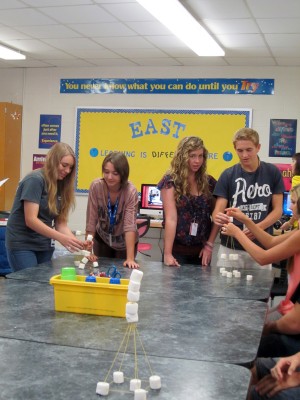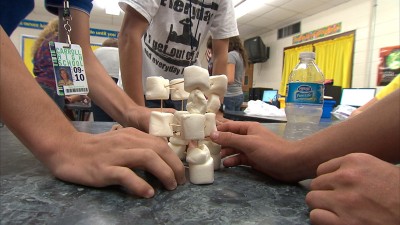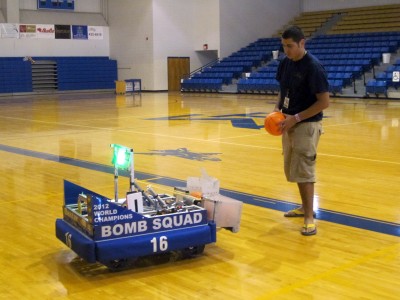Charter, Domestic, K-12, Personalized Learning, Public, Required - Written by Wired Academic on Monday, October 1, 2012 6:00 - 0 Comments
Education Nation: Career Academy Pioneers New Forms Of Personalized Learning
A student from Mountain Home’s robotics team, demonstrates the club’s award winning creation.
By Sarah Butrymowicz, The Hechinger Report
MOUNTAIN HOME, Ark. – Thomas Alexander McLees has always learned best by taking things apart, from a toaster – his mom was not happy, he says – to computers. So in ninth grade, it was easy for him to decide what career academy to enroll in the following year at Mountain Home High School Career Academies.
 Students at Mountain Home High School Career Academies compete to see who can build the tallest tower with marshmallows and toothpicks.
Students at Mountain Home High School Career Academies compete to see who can build the tallest tower with marshmallows and toothpicks.Students are sorted by learning style first, career aspirations second at Mountain Home, a charter high school for grades 10-12. Ninth-grade students go through a battery of personality surveys, discussions and visits from high school representatives and ultimately enroll in Health and Human Services (HHS), Communications, Arts and Business (CAB), or Architecture, Construction, Manufacturing and Engineering (ACME).
The 875-student school, nestled in Arkansas’s Ozark Mountains, is based on two commonly accepted educational tenets: Every student learns differently and students learn best when the material is relevant to them. Mountain Home’s philosophy boils down to the belief that students will be engaged when they are taught in a way that fits their learning style and when they have a chance to apply classroom lessons to real-world problems — and potential careers.
Engagement, the school believes, breeds success.
“We don’t have kids that hide in the bathroom,” CAB Academy Leader Kathy Wham said. “Our kids all belong to one of three families … We draw them out.”
Those in HHS are a bit more reserved, preferring quiet note-taking to absorb information. CAB students are often visual learners with a flair for the dramatic and turn frequently to presentations. Those in ACME — where McLees ended up — are more likely to appreciate hands-on learning.
Students take core classes — English, math, science and history — in the academy they’ve enrolled in but can take electives, which are often more career-oriented, in any other. That way, students can get the basics down in their individual learning style while exploring career options. They can also switch academies at the end of each school year. About 10 of the 600 or so students in 10th and 11th grades do so annually.
Built into the school’s world are unique positions, like Jodi Tejcek’s. She is the “freshman transition leader” responsible for helping ninth-graders pick an academy. The academy’s acronyms also have become adjectives in the community’s lexicon as even adults debate and joke about their own inclinations. Tejcek says, for instance, that she has some very HHS tendencies, whereas Brigitte Shipman, the school’s academy coordinator, is “so CAB.”
Paraphrasing a student, Shipman says career academies have “three separate doors instead of cramming everybody through one big door.”
Other high school career academies exist around the country, but Mountain Home is convinced its longevity is an endorsement of its model. While Mountain Home maintains support from community and students, other career academies have faltered.
The school also prides itself on focusing on studentdriven projects, such as CAB students making videos about classroom etiquette or ACME students building a pavilion for outdoor gatherings. Although the school was partially inspired by local businesses concerned about an aging workforce, students are not guided toward particular careers to meet the needs of industries in town.
“When I was here I had so many opportunities to grow,” said Holly Campbell, a 2012 Mountain Home grad, now in college studying for a career in parks and recreation. “We have such a voice at this school.”
 Students at Mountain Home High School Career Academies compete to see who can build the tallest tower with marshmallows and toothpicks.
Students at Mountain Home High School Career Academies compete to see who can build the tallest tower with marshmallows and toothpicks.
Mountain Home, at which about half of students are eligible for free or reduced-priced lunch, consistently outperforms state averages on standardized tests and the ACT. In the 2011-2012 school year, its students averaged a 22 on the college readiness test, higher than the statewide average of 20 and the national average of 21. Only about 3 to 4 percent of students drop out each year, mostly because of family and financial pressures, according to Shipman. Nationally, 4.1 percent of students dropped out in 2008- 09, the most recently available data, according to the National Center for Education Statistics.
But although 70 to 80 percent of Mountain Home graduates go on to two- or four-year colleges, 30 to 40 percent of them end up in remedial courses in college, according to the school’s data. Nationwide in 2007-08, about 36 percent of students took remedial courses.
Principal Dana Brown said college remediation was a problem the school needed to address and was indicative of a disconnect between high school standards and college expectations.
Other graduates enter the military or a certificate program, or get a job.
Guidance counselor Nancy Parish estimated that roughly 20 students in any given class of about 300 have no plans at the end of high school. The school has started tracking students two years after graduation. Although administrators have no formal data yet, so far the majority of students seem to be sticking with their original plan, Parish said.
Parish stresses to students that they have many options.
“When you say the word ‘college,’ you’ve got a certain percentage of kids who turn off,” Parish said. “[We tell them,] we want you to have training.”
On the first day of an Algebra 2 class this school year, Wham broke her students into small groups, each with a different problem posed by a “manager.”
“This is a problem your company is solving,” Wham said as she walked around the room. “You can’t go ask the boss. You’ve got to work with the group.”
At Mountain Home, aspiring vets practice giving shots to large animals brought to the school by local professionals. Engineers-to-be learn computer drawing programs. Students interested in communications might film and edit video while geometry classes figure out how many stones are needed to pave areas of the school.
“We’ve just had so many opportunities going through all this to be prepared for reality,” senior Megan Cantrell said.
Many seniors are also placed in internships for school credit at local businesses. Each semester, 20 to 25 go to Baxter Regional Medical Center, for instance. Cantrell, an HHS student, will be shadowing a doctor this spring.
Teachers spend time out in the business world as well, attending daylong “teacher externships” to pick up new real-world ideas to bring back to class, said Shipman.
Some 100 Mountain Home residents also sign up to mentor a small group of students. They come once a month, bringing in guest speakers from different fields, arranging field trips to nursing homes or prisons, and playing games geared toward lessons in how to give a good interview. Mentors also coach the school’s award winning robotics team.
Community support is the biggest challenge to having a successful career academy, many administrators, business leaders and school board members said.
Mountain Home, with a large retirement community, has a wealth of professionals in many careers nearby, but they often have no connection to the school. It’s up to the staff to educate the community about what career academies mean, administrators believe, and residents are receptive.
“We find mostly all you have to do is ask,” Shipman said.
Another challenge is the misconception that students are asked to pick a career in ninth grade. Faculty argue that students are given time to experiment and find out what they like and — just as important — what they don’t like.
Those who do go to college find themselves ahead of their peers from other schools, said Kathy Gonten, ACME’s leader. “Their other friends are trying to figure out what their interests are,” she said. But Mountain Home students “go to college with pretty set ideas, and they’re based on fact, not fantasy.”
THE CHALLENGE
By 2020, 37 percent of the 54.8 million projected new jobs—many of them in healthcare, education, and information technology—will require “at least some college.”
The Challenge: Americans without a college degree or specific job skills have been hit hardest by the recession—a general high school degree is no longer enough to remain a competitive member of the workforce.
A Solution: Career Academies are industry-specific, career-focused tracks within high schools that offer small learning communities, college-prep curricula and local partnerships with employers and institutions of higher education.
(Source: Bureau of Labor and Statistics)
RESULTS
- Since 2003 when Mountain Home High School converted to a career academy school, the percentage of students scoring at or above proficient on state exams in literacy increased 20 percentage points.
- The percentage of students scoring scoring at or above proficient on algebra increased 58 percentage points.
- Principal Dana Brown says her students consistently score above state and national averages on tests, in part because her teachers are focused on making their curricula relevant.
This story was produced by The Hechinger Report, a non-profit, independent journalism organization housed at Columbia University in New York.
Campus Buzz
We welcome Tips & Pitches
Latest WA Original Features
-
“Instreamia” Shakes Loose Moss By Launching Spanish Language Mini-MOOC
-
Jörn Loviscach: A German Math Teaching Sensation Emerges On YouTube & Udacity
-
Open University Enters Battle Of The MOOCs, Launches “FutureLearn”
-
Alvaro Salas As A Case Study In Crowd-Funding An Ivy-League Education
-
Jonathan Mugan: How To Build A Free Computer Within A Computer For Your Child
Paul Glader, Managing Editor
@paulglader
Eleni Glader, Policy Editor
Elbert Chu, Innovation Editor
@elbertchu
Biagio Arobba, Web Developer
@barobba
Contributors:
Michael B. Horn
@michaelbhorn
Derek Reed
@derekreed
Annie Murphy Paul
@AnnieMurphyPaul
Frank Catalano
@FrankCatalano
Ryan Craig
@UniVenturesFund
Jonathan Mugan
@JMugan
Terry Heick
@TeachThought
Alison Anderson
@tedrosececi
Ravi Kumar
@ravinepal

The Pulitzer Prize winning investigation newsroom digs into for-profit education.
-
Most Viewed
- Inside Ashford University: A former staffer talks to WiredAcademic
- Infographic: A History Of Information Organization From Stone-Age To Google
- Davos: 12-Year-Old Pakistani Prodigy Girl Talks About Her Online Learning
- Open University Enters Battle Of The MOOCs, Launches "FutureLearn"
- Pearson Llc + Google Expands LMS Business With "OpenClass" System
-
MARKET INTRADAY SNAPSHOT
- Education & Tech Companies We Follow
| APEI | 40.20 |  0.00 0.00 |  +0.00% +0.00% | ||
| APOL | 19.01 |  0.00 0.00 |  +0.00% +0.00% | ||
| AAPL | 460.16 |  0.00 0.00 |  +0.00% +0.00% | ||
| BPI | 10.74 |  0.00 0.00 |  +0.00% +0.00% | ||
| CAST | 0.11 |  0.00 0.00 |  +0.00% +0.00% | ||
| CECO | 4.08 |  0.00 0.00 |  +0.00% +0.00% | ||
| COCO | 2.40 |  0.00 0.00 |  +0.00% +0.00% | ||
| CPLA | 32.03 |  0.00 0.00 |  +0.00% +0.00% | ||
| DV | 30.69 |  0.00 0.00 |  +0.00% +0.00% | ||
| EDMC | 4.03 |  0.00 0.00 |  +0.00% +0.00% | ||
| ESI | 18.34 |  0.00 0.00 |  +0.00% +0.00% | ||
| GOOG | 792.89 |  0.00 0.00 |  +0.00% +0.00% | ||
| LINC | 6.20 |  0.00 0.00 |  +0.00% +0.00% | ||
| LOPE | 25.03 |  0.00 0.00 |  +0.00% +0.00% | ||
| PEDH | 0.45 |  0.00 0.00 |  +0.00% +0.00% | ||
| PSO | 18.51 |  0.00 0.00 |  +0.00% +0.00% | ||
| SABA | 8.61 |  0.00 0.00 |  +0.00% +0.00% | ||
| SCHL | 30.87 |  0.00 0.00 |  +0.00% +0.00% | ||
| STRA | 51.95 |  0.00 0.00 |  +0.00% +0.00% | ||
| WPO | 414.41 |  0.00 0.00 |  +0.00% +0.00% |
Domestic, For-Profit, Gainful Employment, Infographics, Personalized Learning, Private, Public, Required, Universities & Colleges - Jan 31, 2013 6:09 - 0 Comments
Infographic: To Get A Degree Or Not To Get A Degree? Here Is An Answer
More In For-Profit
- Ryan Craig: American Clampdown Forcing Forlorn For-Profit Colleges To Look Abroad
- How For-Profit Colleges Major In Marketing & Fail Education
- Infographic: A Graphical Profile Of Today’s Online College Student
- Infographic: A Comparison Of For-Profits v. Non-Profit Online College Data
- Opinion: How “Shareholder Value” Is Destroying For-Profit, Career Colleges
Cost of Education Domestic Education Quality Ethics For-Profit Friend, Fraud, or Fishy Gainful Employment Graduation Rates Legislation Minorities Opinion Recruitment Regulatory Required Retention Rates Student Loans Universities & Colleges
MOOCs, Required, Technology - Feb 16, 2013 10:04 - 1 Comment
MOOC Monitor: Must Reads This Week
More In Technology
- Infographic: Rise of the MOOCs
- Smart Cities Part II: Why DC Is The Planetary Hub Of Online Learning
- Five Questions: Polling EdTech Startup UnderstoodIt’s Liam Kaufman
- Infographic: The Future of Higher Education
- Anne Collier: Study Shows eBooks Gaining Larger Share & Boosting Overall Reading Habits
Domestic K-12 Parents Reading / Literature Required Technology
Cost of Education, Domestic, Early Childhood Education, Education Quality, Friend, Fraud, or Fishy, Legislation, Minorities, Parents, Public, Required - Feb 18, 2013 4:59 - 0 Comments
Important Early Questions Over Obama’s Early Childhood Program Ambitions
More In Friend, Fraud, or Fishy
- Should For-Profit Companies Manage K-12 Schools? A Skeptical Review
- A Letter To Sen. Tom Harkin About For-Profit Charter Schools
- Ryan Craig: American Clampdown Forcing Forlorn For-Profit Colleges To Look Abroad
- Opinion: The Problem With Deceptive Degree Aggregators In The Search For Online Courses & Degrees
- How For-Profit Colleges Major In Marketing & Fail Education
Domestic Education Quality Ethics For-Profit Friend, Fraud, or Fishy Graduation Rates Minorities Recruitment Required Retention Rates Universities & Colleges



Leave a Reply